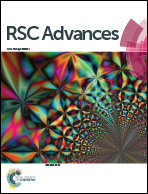Peroxide-free synthesis of benzo[b][1,4]thiazine 1,1-dioxides and their antimicrobial study†
Abstract
A peroxide-free reaction protocol for the oxidation of benzo[b][1,4]thiazines has been developed under mild conditions. A library of benzo[b][1,4]thiazine 1,1-dioxide derivatives with broad functionalities have been synthesized in high yields. An in vitro antimicrobial study along with statistical analysis, MIC study and bacterial killing kinetics were investigated. The synthesized 1,4-benzothiazine sulfone derivatives possess strong antimicrobial activity against the reference strains.
![Graphical abstract: Peroxide-free synthesis of benzo[b][1,4]thiazine 1,1-dioxides and their antimicrobial study](/en/Image/Get?imageInfo.ImageType=GA&imageInfo.ImageIdentifier.ManuscriptID=C5RA20541G&imageInfo.ImageIdentifier.Year=2016)

 Please wait while we load your content...
Please wait while we load your content...